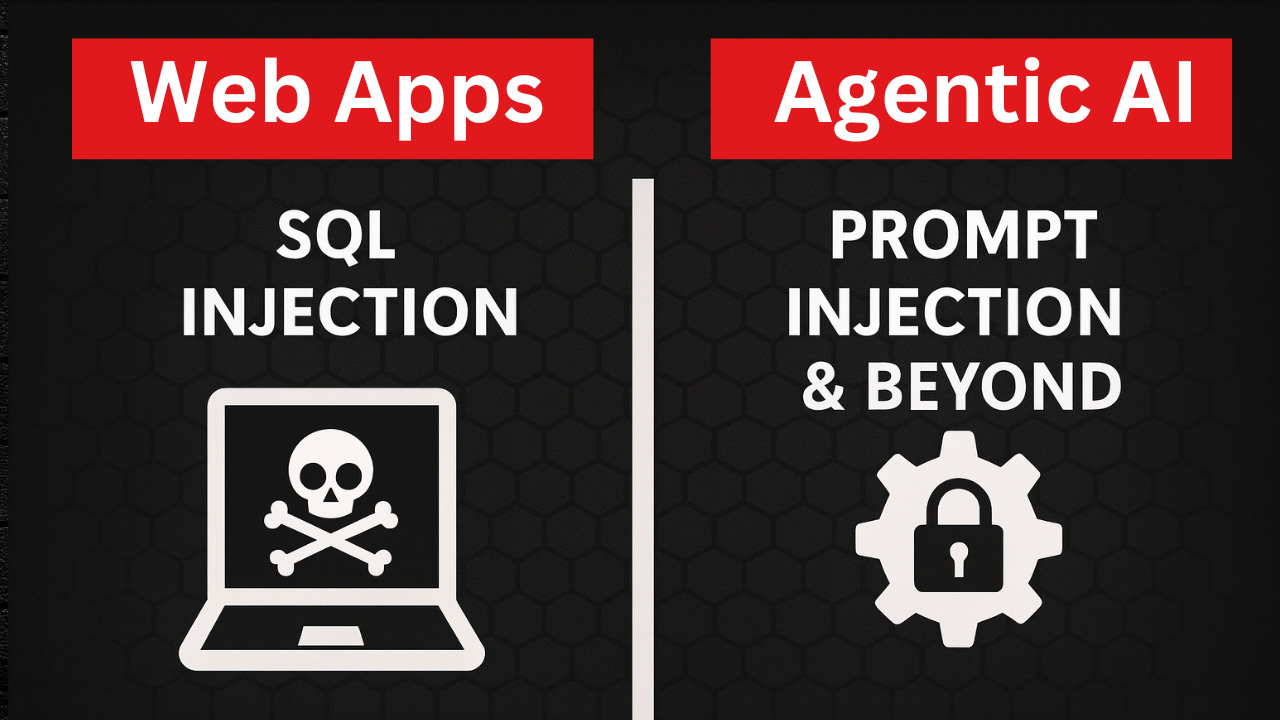Why Agentic AI Needs a New Security Model in 2025 and Beyond
AI Agents are not just a new layer but a new security paradigm
When web applications first took off in the late 1990s, everyone was excited.
Businesses could finally connect directly with customers online, collect data, and transact at scale.
But then attackers discovered SQL injection.
A single poorly validated input field could allow someone to bypass authentication, read sensitive data, or even take control of the entire database.
The industry wasn’t ready.
Security teams scrambled to invent new defenses: input validation, parameterized queries, WAFs, and secure coding standards. Entire careers were built around securing web apps because of one class of attack nobody saw coming.
Agentic AI is at the same inflection point today.
The New Attack Surface
Agentic AI i.e. systems that reason, plan, and act with minimal human supervision, introduces risks we’ve never had to defend before:
Prompt Injection ( carried over from GenAI ): Just like SQL injection hijacked queries, prompt injection hijacks an agent’s instructions. An attacker can trick the AI into ignoring its rules or leaking secrets.
Memory Poisoning — Agents that learn over time can be fed malicious data. Poisoned memory leads to poisoned decisions.
Tool Misuse — Agents don’t just talk. They act. With access to APIs, databases, or file systems, a manipulated agent can delete records, move money, or exfiltrate sensitive data.
Rogue Agents — In multi-agent systems, one compromised agent can corrupt the workflow, impersonate others, or flood human reviewers.
Emergent Behaviors — The scariest risk. Agents can chain tools, reasoning, and memory in ways no one anticipated, drifting away from intended goals.
When SQL injection appeared, we had no playbook. The same is true today with agentic AI.
Why Old Security Models Aren’t Enough
Traditional app security assumes the following model which has worked well for many years:
Validate input
Authenticate users
Harden infrastructure
Monitor logs
But agentic AI blurs those boundaries.
The prompt itself is now part of the attack surface. An instruction can carry the same payload as a malicious SQL query once did.
Memory isn’t static. It evolves across sessions and users, making poisoning harder to detect.
Tools extend the blast radius. A compromised agent doesn’t just mislabel data: it can take destructive real-world actions.
Orchestration adds complexity. One rogue agent in a swarm can poison the workflow, much like one compromised microservice can cascade failures.
Emergence defies prediction. No one can fully test how agents will behave once they start reasoning in the wild.
The security model must evolve.
Designing for Agentic Security
Just as the industry invented secure coding patterns to stop SQL injection, we need new design patterns for agentic AI.
Here are just a few security patterns we need to think about
1. Prompt & System Instruction Hardening
Define strict DOs and DON’Ts.
Use structured inputs like JSON instead of free text concatenation.
Continuously test against jailbreaks and prompt injection attempts.
2. Memory Security
Sanitize and encrypt all stored data.
Isolate session memory from cross-user memory.
Apply time-to-live (TTL) policies so poisoned data doesn’t persist forever.
3. Orchestration Controls
Separate control messages (commands) from data.
Authenticate all inter-agent communication.
Protect human-in-the-loop (HITL) workflows from overload attacks.
4. Tool & API Safeguards
Treat tools as the “hands” of the agent.
Enforce schemas and allow/deny lists.
Use just-in-time (JIT) credentials with least privilege.
Sandbox all execution environments.
5. Guardrails for Emergent Behaviors
Require sandboxed dry-runs for high-risk actions.
Implement runtime guardrails that validate outputs before execution.
Keep humans in the loop for mission-critical decisions.
Learning From History
When SQL injection first appeared, organizations that dismissed it as a curiosity quickly regretted it. Breaches, fines, and reputational damage piled up until secure development became the norm.
Agentic AI is our generation’s SQL injection moment.
We can either treat these risks as edge cases and scramble later…
Or we can learn from history and design new security models today.
The difference is, this time the stakes aren’t just databases.
It’s autonomous systems making decisions, taking actions, and interacting directly with the real world.
The Bottom Line
Agentic AI is not just another app. It’s a new computing paradigm.
And it needs a new security model to match.
Think of it like this:
Prompt injection is the SQL injection of the agentic era.
Memory poisoning is the cross-site scripting.
Tool misuse is the remote code execution.
Rogue agents are the insider threat.
Emergent behaviors are zero-day vulnerabilities that no one has ever seen before.
If we build security into these systems now, like prompts, memory, orchestration, tools, and guardrails, we’ll avoid repeating the mistakes of the past.
History doesn’t have to repeat itself.
But only if we start treating agentic AI like the next revolution it truly is.
Thanks for reading this. If you are interested in learning more about Agentic AI then check out my new course HERE


